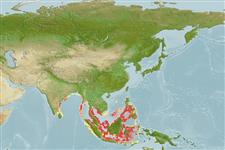Common names from other countries
>
Gobiiformes (Gobies) >
Gobiidae (Gobies) > Gobiinae
Etymology: Trimma: Greek, trimma, -atos = something crushed (Ref. 45335); fucatum: Name from Latin ‘fucatus’, meaning painted, coloured, or rouged; referring to the red markings on and around the preopercle..
More on authors: Winterbottom & Southcott.
Environment: milieu / climate zone / depth range / distribution range
Ecologie
marien rifbewoner; diepte 0 - 23 m (Ref. 59340). Tropical
Indo-West Pacific: Andaman Sea, Phuket, Thailand, Myanmar and Indonesia.
Grootte / Gewicht / Leeftijd
Maturity: Lm ? range ? - ? cm
Max length : 2.0 cm SL mannelijk / geslacht onbekend; (Ref. 59340)
Korte beschrijving
Determinatiesleutels | Morfologie | Morfometrie
Dorsale stekels (totaal) : 7; Dorsale zachte stralen (totaal) : 7 - 9; Anale stekels: 1; Anale zachte stralen: 7 - 8. This species is distinguished by having predorsal scales; second and third dorsal spines not elongated; with interorbital and postorbital trenches; opercular scales 2; a single dichotomous branch in the fifth pelvic-fin ray; when alive has three or four rows of yellow to orange blotches along the body and a narrow red bar on the vertical limb of the preopercle (Ref. 59340); characterized further by having longitudinal scale series 21-25; predorsal scales 4-5; cheek without scales; depth of body 4.3 in SL (Ref. 90102).
Collected specimens came from patch reefs and coral slopes with diverse coral cover, except for the 3 specimens collected from a steep (45°) wall of large boulders with little algal or coral growth (Ref. 59340).
Levenscyclus en paargedrag
Maturities | Voortplanting | Spawnings | Egg(s) | Fecundities | Larven
Winterbottom, R. and L. Southcott, 2007. Two new species of the genus Trimma (Percomorpha: Gobioidei) from western Thailand. aqua, Int. J. Ichthyol. 13(2):69-76. (Ref. 59340)
Status op de Rode Lijst van het IUCN (Ref. 130435)
CITES (Ref. 128078)
Not Evaluated
Gevaar voor de mens
Harmless
Gebruik door de mens
Tools
Speciale rapporten
Download XML
Internetbronnen
Estimates based on models
Preferred temperature (Ref.
115969): 28.6 - 29.3, mean 29 (based on 446 cells).
Fylogenetische diversiteitsindex (Ref.
82804): PD
50 = 0.5000 [Uniqueness, from 0.5 = low to 2.0 = high].
Bayesian length-weight: a=0.01023 (0.00477 - 0.02194), b=3.02 (2.84 - 3.20), in cm Total Length, based on LWR estimates for this (Sub)family-body shape (Ref.
93245).
Weerstandsvermogen (Ref.
120179): Hoog, minimale populatieverdubbelingstijd minder dan 15 maanden (Preliminary K or Fecundity.).
Fishing Vulnerability (Ref.
59153): Low vulnerability (10 of 100).
